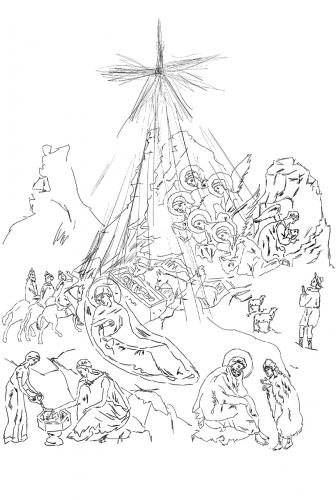



The Nativity of Jesus
Iconographically, the Nativity of Jesus is a very intricate theme, based on the texts of the Gospels according to Luke (2:1-20) and Mark (2:9-11), but also on apocryphal sources, as far as the number of Magi or the midwife and her help, Salome's presence are concerned.
In the elementary variants of the theme, based only on Luke, the Holy Family is shown in the cave, also on the scene being present the angels and the shepherds. The cave is part of a hilly, even rocky landscape. A tired Virgin lies along the swaddled Child, crowned by a cruciger halo. By the manger, looking towards the Infant, there are the canonical animals: the ox and the donkey. St. Joseph, depicted as a bearded, grey-haired man, holding his head in his arm, is sitting at the cave entrance. High in the sky the angels are worshipping the Child, one of them bringing the good tidings of the birth to the shepherds. Usually, there are two shepherds guarding their flocks. In most of the representations of the Nativity scene the Star mentioned in Matthew (2:1-10) appears, one of its rays descending towards the Child.
In more elaborate variants of the Nativity, the Bethlehem shepherds are seen near the cave entrance, as they came to see the Child, the elder one addressing St. Joseph. Sometimes, in order to stress the succession of the narrative moments, the shepherds are placed on the slope of the hill, besides their flocks, listening to the angel bringing them the good tidings and also at the cave entrance, speaking to St. Joseph.
In the most complex representations of the Nativity scene, along the characters already described, the Magi, mentioned in Matthew (2:1-11), are also present (see the canon The Adoration of the Magi), as well as the two women mentioned in the apocryphal Gospel of James: the pious midwife and her doubting assistant, Salome. Iconographically, the two feminine characters are seen in the foreground, at the bottom of the scene, bathing the Infant Jesus before swaddling Him.
Iconographically, the Nativity of Jesus is a very intricate theme, based on the texts of the Gospels according to Luke (2:1-20) and Mark (2:9-11), but also on apocryphal sources, as far as the number of Magi or the midwife and her help, Salome's presence are concerned.
In the elementary variants of the theme, based only on Luke, the Holy Family is shown in the cave, also on the scene being present the angels and the shepherds. The cave is part of a hilly, even rocky landscape. A tired Virgin lies along the swaddled Child, crowned by a cruciger halo. By the manger, looking towards the Infant, there are the canonical animals: the ox and the donkey. St. Joseph, depicted as a bearded, grey-haired man, holding his head in his arm, is sitting at the cave entrance. High in the sky the angels are worshipping the Child, one of them bringing the good tidings of the birth to the shepherds. Usually, there are two shepherds guarding their flocks. In most of the representations of the Nativity scene the Star mentioned in Matthew (2:1-10) appears, one of its rays descending towards the Child.
In more elaborate variants of the Nativity, the Bethlehem shepherds are seen near the cave entrance, as they came to see the Child, the elder one addressing St. Joseph. Sometimes, in order to stress the succession of the narrative moments, the shepherds are placed on the slope of the hill, besides their flocks, listening to the angel bringing them the good tidings and also at the cave entrance, speaking to St. Joseph.
In the most complex representations of the Nativity scene, along the characters already described, the Magi, mentioned in Matthew (2:1-11), are also present (see the canon The Adoration of the Magi), as well as the two women mentioned in the apocryphal Gospel of James: the pious midwife and her doubting assistant, Salome. Iconographically, the two feminine characters are seen in the foreground, at the bottom of the scene, bathing the Infant Jesus before swaddling Him.




